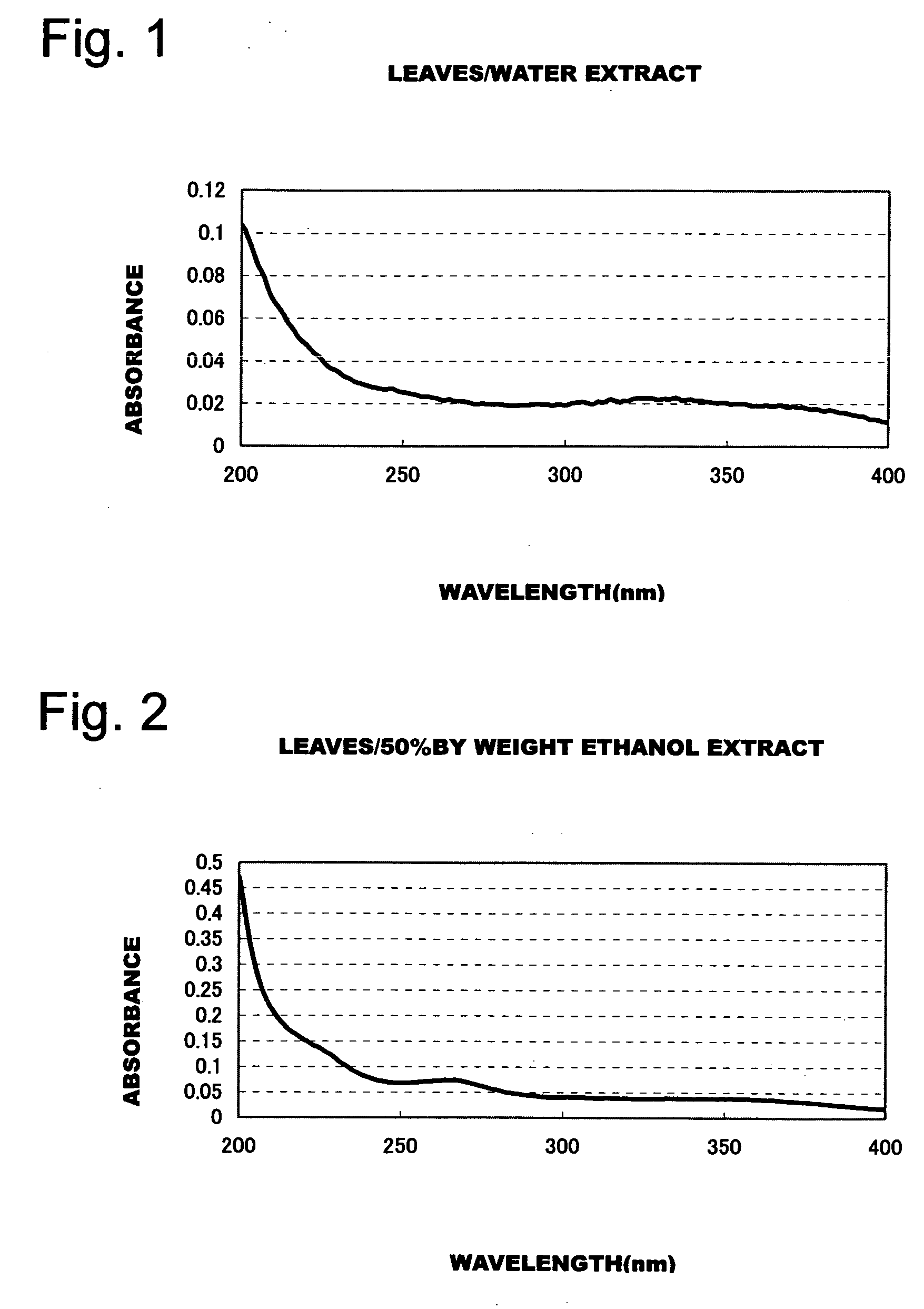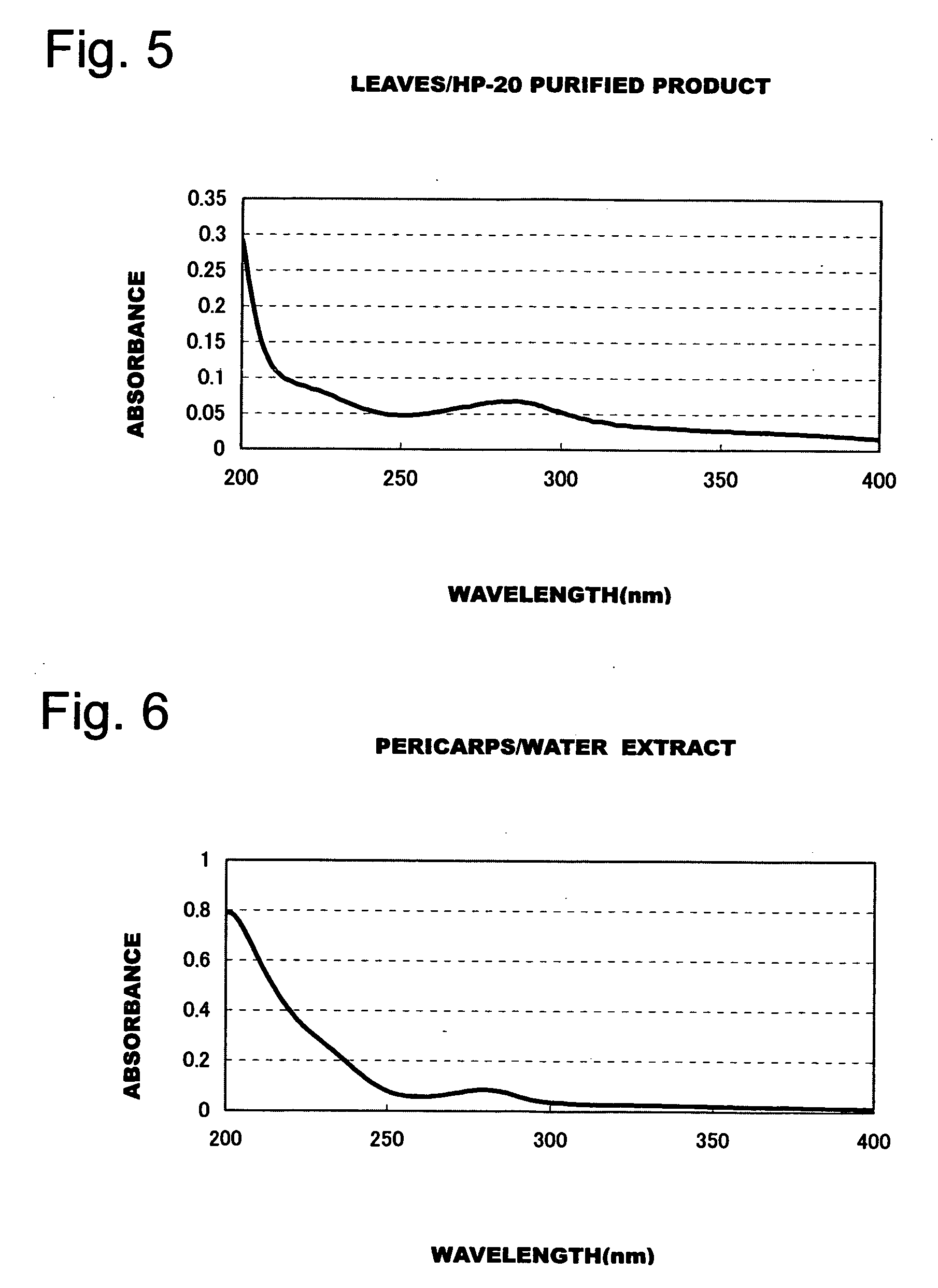Flavor deterioration inhibitor and inhibitor for the generation of citral deterioration smell
a technology of flavor deterioration and citral deterioration, which is applied in the field of flavor deterioration inhibitors, can solve the problems of flavor deterioration, loss of aroma and delicious taste, unpalatable taste, etc., and achieve the effects of inhibiting flavor deterioration, high safety, and inhibiting flavor deterioration
- Summary
- Abstract
- Description
- Claims
- Application Information
AI Technical Summary
Benefits of technology
Problems solved by technology
Method used
Image
Examples
example 1
Extraction Example 1
[0086] Leaves / extraction with Water
[0087] Extraction was carried out by adding 500 g of water to 50 g of dried leaves of Ashitaba and heating under reflux for one hour.
[0088] After removing insoluble by filtration, the filtrate was concentrated under reduced pressure and freeze-dried to give 10.1 g of a pale yellow powder (hereinafter referred to as “leaves / water extract”). This extract had the following physical properties: [0089] a) An ultraviolet spectrum is as shown in FIG. 1 (measurement concentration: 10 ppm, dilution solvent: distilled water).
λmax: 334 nm, 246 nm [0090] b) Solubility: Readily soluble in water, soluble in a 50% by weight aqueous solution of ethanol, insoluble in ethanol.
Extraction Example 2
[0091] Leaves / Extraction with 50% by Weight Aqueous Solution of Ethanol
[0092] Extraction was carried out by adding 500 g of a 50% by weight aqueous solution of ethanol to 50 g of dried leaves of Ashitaba and heating under reflux for one hour.
[0093]...
example 2
[0149] Margarine
[0150] A mixture of 55 g of shortening, 15 g of corn oil, 0.1 g of a 30% β-carotene solution, 0.2 g of lecithin and 0.3 g of an emulsifier was sterilized by warming in hot water at 80° C. for 10 minutes. On the other hand, a mixture of 27.9 g of water, 0.5 g of sodium chloride, 1 g of skim milk powder and 0.1 g of a 1% by weight solution of the Ashitaba leaves / water extract in a 50% by weight aqueous solution of ethanol was heated up to 85° C. in a hot water bath. The corn oil mixture and skim milk powder mixture thus obtained were cooled to 50-60° C., respectively, and then both were admixed and stirred at 1,500 rpm for 5 minutes using disper, while cooling in ice-water. The whole mixture was kneaded well with a rubber spatula while cooling in water (cooling down to 10° C.). It was placed into a vessel and matured in a refrigerator overnight to finish margarine.
example 3
[0151] (Vanilla Extract)
[0152] A mixture of 10 g of vanilla beans with 35 g of ethanol and 65 g of distilled water was allowed to stand at room temperature in the dark for 4 weeks to accomplish extraction. This solution was filtered to obtain 90 g of vanilla extract. To 90 g of the extract was added 10 g of a 1% by weight solution of the Ashitaba stems / 50% by weight ethanol extract in a 50% by weight aqueous solution of ethanol to finish vanilla extract of this invention.
PUM
 Login to View More
Login to View More Abstract
Description
Claims
Application Information
 Login to View More
Login to View More - R&D
- Intellectual Property
- Life Sciences
- Materials
- Tech Scout
- Unparalleled Data Quality
- Higher Quality Content
- 60% Fewer Hallucinations
Browse by: Latest US Patents, China's latest patents, Technical Efficacy Thesaurus, Application Domain, Technology Topic, Popular Technical Reports.
© 2025 PatSnap. All rights reserved.Legal|Privacy policy|Modern Slavery Act Transparency Statement|Sitemap|About US| Contact US: help@patsnap.com



